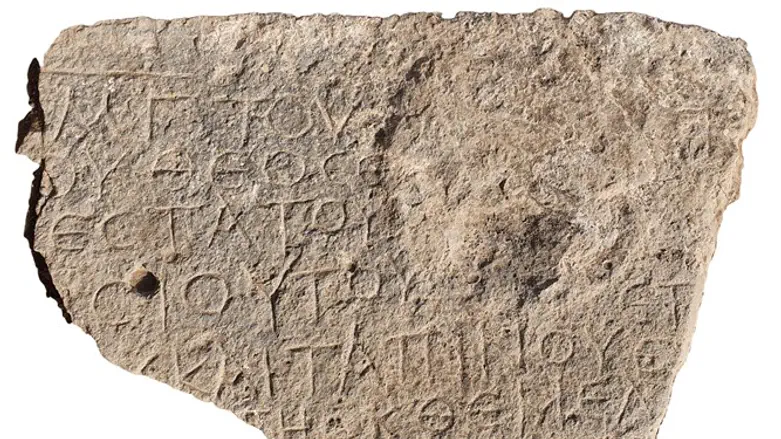
Israel Antiquities Authority excavations in the village of et-Taiyiba in the Jezreel Valley recently unearthed an inscription dedicated to "Jesus, the Son of Mary". The Greek inscription, engraved in stone, comes from the frame of an entrance door dating from the Byzantine period (late fifth century CE).
It was discovered incorporated in secondary use in one of the walls of a magnificent building dating from the Byzantine or Early Islamic period, where the excavations uncovered two rooms containing mosaic pavements with a geometric design.
The inscription was recovered in an archaeological excavation directed by Tzachi Lang and Kojan Haku of the Israel Antiquities Authority prior to the construction of a road inside the village. As part of the Israel Antiquities Authority’s policy of increasing public interest in archaeology, students, volunteers and workers from the local community, participated in the excavation.
According to Dr Leah Di-Segni, researcher at the Institute of Archaeology of the Hebrew University of Jerusalem, who deciphered the text, it is a dedicatory inscription that was engraved while casting the foundations of the church.
It reads, “Christ born of Mary. This work of the most God-fearing and pious bishop [Theodo]sius and the miserable Th[omas] was built from the foundation - -. Whoever enters should pray for them.” According to Di-Segni, the formula “Christ born of Mary” was intended to protect its readers from the evil eye and it was commonly used at the beginning of inscriptions and documents of the time. Christ (Christos in Greek, or ‘Messiah’) refers to Jesus. Di-Segni adds that “The inscription greets those who enter and blesses them. It is therefore clear that the building is a church, and not a monastery: Churches greeted believers at their entrance, while monasteries tended not to do this.”
Theodosius, whom the text refers to as the building’s founder, was one of the first Christian bishops.
He served as the regional archbishop – the supreme religious authority of the metropolis of Bet She’an, to which et-Taiyiba in the valley belonged. Dr Walid Atrash of the Israel Antiquities Authority says, “This is the first evidence of the Byzantine church’s existence in the village of et-Taiyiba and it adds to other finds attesting to the activities of Christians who lived in the region. Remains of a church from the Crusader period were previously uncovered at the site, and a monastery discovered more recently by Nurit Feig of the Israel Antiquities Authority and Dr Moti Aviam of Kinneret College in Kfar Kama is one of a series of monasteries that were under the jurisdiction of the Bet She’an religious metropolis.”
According to excavation directors Tzachi Lang and Kojan Haku of the Israel Antiquities Authority, “The excavation yielded finds from a variety of periods, shedding light on the long settlement sequence at et-Taiyiba in the valley, and on its status among the local settlements.”